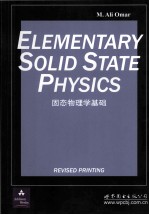图书介绍
固态物理学基础PDF|Epub|txt|kindle电子书版本网盘下载

- (美)奥马尔著 著
- 出版社: 上海:世界图书上海出版公司
- ISBN:9787510035197
- 出版时间:2011
- 标注页数:669页
- 文件大小:119MB
- 文件页数:684页
- 主题词:固体物理学-英文
PDF下载
下载说明
固态物理学基础PDF格式电子书版下载
下载的文件为RAR压缩包。需要使用解压软件进行解压得到PDF格式图书。建议使用BT下载工具Free Download Manager进行下载,简称FDM(免费,没有广告,支持多平台)。本站资源全部打包为BT种子。所以需要使用专业的BT下载软件进行下载。如BitComet qBittorrent uTorrent等BT下载工具。迅雷目前由于本站不是热门资源。不推荐使用!后期资源热门了。安装了迅雷也可以迅雷进行下载!
(文件页数 要大于 标注页数,上中下等多册电子书除外)
注意:本站所有压缩包均有解压码: 点击下载压缩包解压工具
图书目录
Chapter 1 Crystal Structures and Interatomic Forces2
1.1 Introduction2
1.2 The crystalline state2
1.3 Basic definitions3
1.4 The fourteen Bravais lattices and the seven crystal systems7
1.5 Elements of symmetry10
1.6 Nomenclature of crystal directions and crystal planes;Miller indices12
1.7 Examples of simple crystal structures16
1.8 Amorphous solids and liquids20
1.9 Interatomic forces23
1.10 Types of bonding24
Chapter 2 X-Ray,Neutron,and Electron Diffraction in Crystals34
2.1 Introduction34
2.2 Generation and absorption of x-rays34
2.3 Bragg's law35
2.4 Scattering from an atom37
2.5 Scattering from a crystal42
2.6 The reciprocal lattice and x-ray diffraction46
2.7 The diffraction condition and Bragg's law51
2.8 Scattering from liquids53
2.9 Experimental techniques55
2.10 Other x-ray applications in solid-state physics58
2.11 Neutron diffraction59
2.12 Electron diffraction60
Chapter 3 Lattice Vibrations:Thermal,Acoustic,and Optical Properties68
3.1 Introduction68
3.2 Elastic waves68
3.3 Enumeration of modes;density of states of a continuous medium70
3.4 Specific heat:models of Einstein and Debye75
3.5 The phonon86
3.6 Lattice waves87
3.7 Density of states of a lauice104
3.8 Specific heat:exact theory107
3.9 Thermal conductivity107
3.10 Scattering of x-rays,neutrons,and light by phonons112
3.11 Microwave ultrasonics117
3.12 Lattice optical properties in the infrared121
Chapter 4 Metals Ⅰ:The Free-Electron Model138
4.1 Introduction138
4.2 Conduction electrons138
4.3 The free-electron gas140
4.4 Electrical conductivity142
4.5 Electrical resistivity versus temperature147
4.6 Heat capacity of conduction electrons151
4.7 The Fermi surface154
4.8 Electrical conductivity:effects of the Fermi surface156
4.9 Thermal conductivity in metals157
4.10 Motion in a magnetic field:cyclotron resonance and the Hall effect160
4.11 The AC conductivity and optical properties163
4.12 Thermionic emission167
4.13 Failure of the free-electron model169
Chapter 5 Metals Ⅱ:Energy Bands in Solids176
5.1 Introduction176
5.2 Energy spectra in atoms,molecules,and solids176
5.3 Energy bands in solids;the Bloch theorem179
5.4 Band symmetry in k-space;Brillouin zones184
5.5 Number of states in the band188
5.6 The nearly-free-electron model189
5.7 The energy gap and the Bragg reflection196
5.8 The tight-binding model198
5.9 Calculations of energy bands205
5.10 Metals,insulators,and semiconductors210
5.11 Density of states213
5.12 The Fermi surface216
5.13 Velocity of the Bloch electron221
5.14 Electron dynamics in an electric field225
5.15 The dynamical effective mass227
5.16 Momentum,crystal momentum,and physical origin of the effective mass230
5.17 The hole233
5.18 Electrical conductivity235
5.19 Electron dynamics in a magnetic field:cyclotron resonance and the Hall effect238
5.20 Experimental methods in determination of band structure241
5.21 Limit of the band theory;metal-insulator transition244
Chapter 6 Semiconductors Ⅰ:Theory254
6.1 Introduction254
6.2 Crystal structure and bonding254
6.3 Band structure257
6.4 Carrier concentration;intrinsic semiconductors260
6.5 Impurity states265
6.6 Semiconductor statistics269
6.7 Electrical conductivity;mobility272
6.8 Magnetic field effects:cyclotron resonance and Hall effect278
6.9 Band structure of real semiconductors282
6.10 High electric field and hot electrons287
6.11 The Gunn effect288
6.12 Optical properties:absorption processes292
6.13 Photoconductivity300
6.14 Luminescence302
6.15 Other optical effects304
6.16 Sound-wave amplification(acoustoelectric effect)304
6.17 Diffusion306
Chapter 7 Semiconductors Ⅱ:Devices320
7.1 Introduction320
7.2 The p-n junction:the rectifier320
7.3 The p-n junction:the junction itself330
7.4 The junction transistor335
7.5 The tunnel diode338
7.6 The Gunn diode340
7.7 The semiconductor laser346
7.8 The field-effect transistor,the semiconductor lamp,and other devices353
7.9 Integrated circuits and microelectronics361
Chapter 8 Dielectric and Optical Properties of Solids372
8.1 Introduction372
8.2 Review of basic formulas372
8.3 The dielectric constant and polarizability;the local field376
8.4 Sources of polarizability381
8.5 Dipolar polarizability384
8.6 Dipolar dispersion389
8.7 Dipolar polarization in solids394
8.8 Ionic polarizability398
8.9 Electronic polarizability400
8.10 Piezoelectricity406
8.11 Ferroelectricity408
Chapter 9 Magnetism and Magnetic Resonances424
9.1 Introduction424
9.2 Review of basic formulas424
9.3 Magnetic susceptibility429
9.4 Classification of materials430
9.5 Langevin diamagnetism431
9.6 Paramagnetism433
9.7 Magnetism in metals441
9.8 Ferromagnetism in insulators444
9.9 Antiferromagnetism and ferrimagnetism450
9.10 Ferromagnetism in metals454
9.11 Ferromagnetic domains457
9.12 Paramagnetic resonance,the maser464
9.13 Nuclear magnetic resonance475
9.14 Ferromagnetic resonance;spin waves479
Chapter 10 Superconductivity496
10.1 Introduction496
10.2 Zero resistance496
10.3 Perfect diamagnetism,or the Meissner effect500
10.4 The critical field501
10.5 Thermodynamics of the superconducting transition503
10.6 Electrodynamics of superconductors507
10.7 Theory of superconductivity511
10.8 Tunneling and the Josephson effect516
10.9 Miscellaneous topics518
Chapter 11 Topics in Metallurgy and Defects in Solids528
11.1 Introduction528
11.2 Types of imperfections528
11.3 Vacancies530
11.4 Diffusion533
11.5 Metallic alloys542
11.6 Dislocations and the mechanical strength of metals555
11.7 Ionic conductivity563
11.8 The photographic process564
11.9 Radiation damage in solids568
Chapter 12 Materials and Solid-State Chemistry578
12.1 Introduction578
12.2 Amorphous semiconductors578
12.3 Liquid crystals587
12.4 Polymers597
12.5 Nuclear magnetic resonance in chemistry604
12.6 Electron spin resonance in chemistry611
12.7 Chemical applications of the M?ssbauer effect617
Chapter 13 Solid-State Biophysics628
13.1 Introduction628
13.2 Biological applications of delocalization in molecules629
13.3 Nucleic acids632
13.4 Proteins634
13.5 Miscellaneous topics640
Appendix Elements of Quantum Mechanics644
A.1 Basic concepts644
A.2 The Schr?dinger equation644
A.3 One-dimensional examples645
A.4 The angular momentum645
A.5 The hydrogen atom;multielectron atoms;periodic table of the elements646
A.6 Perturbation theory647
A.7 The hydrogen molecule and the covalent bond650
A.8 Directed bonds653
Index658